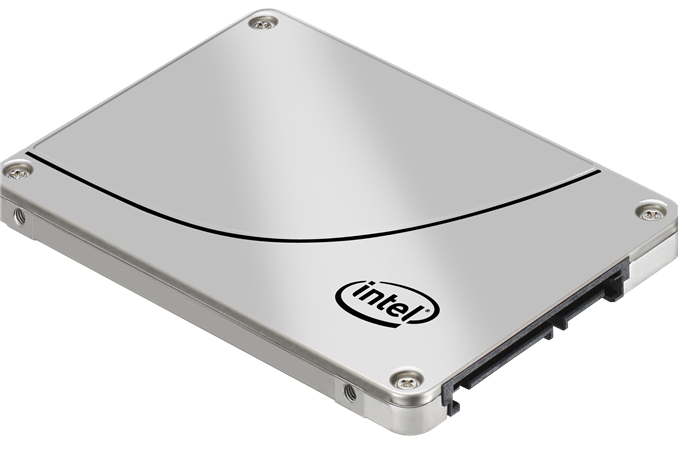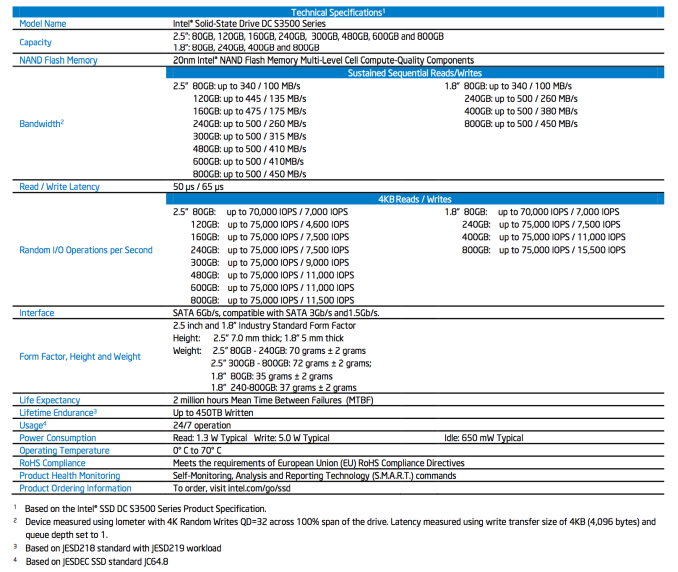Intel SSD DC S3500 Review (480GB): Part 1
by Anand Lal Shimpi on June 11, 2013 6:10 PM EST- Posted in
- Storage
- IT Computing
- SSDs
- Intel
- Datacenter
- Enterprise

Last year Intel introduced its first truly new SSD controller since 2008. Oh how times have changed since then. Intel's original SSD controller design was dual purpose, designed for both consumer and enterprise workloads. Launching first as the brains behind a mainstream Intel SSD, that original controller did a wonderful job of kicking off the SSD revolution that followed. Growing pains and a couple of false starts kept a true successor to Ephraim (Intel's first controller) from ever really surfacing over the next few years.
Last year, Ephraim got a true successor and it came in the form of a very high-end enterprise drive: the Intel SSD DC S3700. Equipped with tons of 25nm HET-MLC NAND, the S3700 officially broke the enterprise addiction to SLC for high endurance drives while raising the bar in all aspects of performance. In addition to the usual considerations however, Intel had a new focus with the S3700: performance consistency.
Due to the nature of NAND flash, there's a lot of background management/cleanup that happens in order to ensure endurance as well as high performance. It's these background management tasks that can dramatically impact performance. I love the cleaning your room analogy because it accurately describes the tradeoffs SSD controller makers have to deal with. Clean early and often and you'll do well. Put off cleaning until later and you'll enjoy tons of free time early but you'll quickly run into a problem. It's an oversimplification, but the latter is what most SSD controllers have done historically, and the former is what Intel always believed in. With the S3700, Intel took it to the next level and built the most consistent performing SSD I'd ever tested.
Performance consistency matters for a couple of reasons. The most obvious is an impact to user experience. Predictable latencies are what you want, otherwise your applications can encounter odd hiccups. In client drives, those hiccups appear as unexpected pauses during application usage. In the enterprise, the manifestation is similar except the user encounters the issue somewhere over the internet rather than locally. The other issue with inconsistent performance really creeps up in massive RAID arrays. With many drives in a RAID array, overall performance is determined by the slowest performing drive. Inconsistent performance, particularly with large downward swings, can result in substantial decrease in the performance of large RAID arrays. The motivation to build a consistently performing SSD is high, but so is the level of difficulty in building such a drive.
Intel had the luxury of being able to start over with the S3700's controller architecture. It moved to a flat indirection table (mapping between LBAs and NAND pages), which incurred a DRAM size penalty but ultimately made it possible to deliver much better performance consistency. The S3700 did amazingly well in our enterprise tests, and produced the most consistent IO consistency curves I'd ever seen. The only downside? Despite being much better priced than the Intel X25-E and SSD 710, the S3700 is still a very expensive drive. The move to a better architecture helped reduce the amount of spare area needed for good performance, which in turn reduced cost, but the S3700 still used Intel's most expensive, highest endurance MLC NAND available (25nm HET-MLC). With the largest versions capable of enduring nearly 15 petabytes of writes, the S3700 was really made for extremely write intensive workloads. The drive performs very well across the board, but if you don't have an extremely write intensive workload you'd be paying for much more than you needed.
We always knew that Intel would build a standard MLC version of the S3700, and today we have that drive: the Intel SSD DC S3500.











54 Comments
View All Comments
nathanddrews - Wednesday, June 12, 2013 - link
The difference is that the S3500 comes over provisioned and the others don't. While you and I have the knowledge and skill to do it ourselves, most people - even IT staff - would have zero clue or interest in how to do something like that.zanon - Wednesday, June 12, 2013 - link
Give me a break, "most people" aren't interested in an S3500 period or even a prosumer drive, their primary focus would be capacity and cost (since at that level any modern SSD at all will be great). By definition, anyone interested in this or other such drives isn't "most people". "IT staff" or prosumers can perfectly well format/partition a drive, an easy GUI for it comes with every OS they'd use, it's hardly the kind of technical operation that'd make it a rare case. And since it only ever needs to be done once and then can be ignored forever, it can even be setup by someone else.Anand has considered it important enough to spend significant time on and test in all other recent reviews, and I think that speaks for itself. It's of direct relevance.
cheeselover - Wednesday, June 12, 2013 - link
does increasing overprovising on the intel drive change the performance much? this article compares s3500 to 600 pro but overprovising is much higher on the seagate drive (512gb of flash to get 400gb of storage). the intel drive is listed as 264gb of flash for 240gb and that translate to 512gb of flash for 480gb.also wondering how the pricing works out considering for the same amount of flash the seagate drives get 20% less storage space.
sallgeud - Wednesday, June 12, 2013 - link
As of right now it's been nearly 6 weeks since the last retailer and wholesaler received their shipments of S3700s. The word from most of them is that we're at least 6 more weeks away from the next expected deliveries. For those of us in the server world, it would be great if they could just produce and ship what they already make... and thus far throwing money at my monitor has done nothing.mtoma - Wednesday, June 12, 2013 - link
Regarding the testing methodology: on page 3, Mr. Shimpi said (as usual) the following: "To generate the data below I took a freshly secure erased SSD and filled it with sequential data". Ok, so how EXACTLY he did that? I mean, secure erasing the Intel SSD. I was in a couple of very frustrating positions, when I tried to secure erase Intel and Samsung SSD's, following the kind (read DUMB) suggestions of Samsung SSD Magician and Intel SSD Toolbox. On the Samsung drive I finnaly did it, I secure erased the drive. On Intel, no way. Intel SSD Toolbox kept saing that I must power down the drive, and then power on. But that din't work. I noticed a lot of angry users of Intel SSDs who could not secure erase their drive.So allow me to repeat the question: HOW MR. SHIMPI SECURE ERASED THE DRIVE? Thanks!
alainiala - Wednesday, June 12, 2013 - link
Interesting, the comment about the high idle power usage making this drive not ideal for consumer use... Our channel partner was recommending this as a replacement for the 320 Series for our laptops.mjz - Thursday, June 13, 2013 - link
why would you even have to upgrade the SSDs in the laptops? I think your channel partner is just trying to make some money. The intel 320 ssd when used in a laptop is good for 98% of tasksneodan - Thursday, June 13, 2013 - link
Unrelated question but if you guys had a choice between having the Crucial M500 480GB or the Samsung 830 512GB for the same price which would pick overall?Wolfpup - Thursday, June 13, 2013 - link
I continue to be a firm believer in Micron/Crucial and Intel's drives-quality and reliability and non-flakieness over (sometimes) better performance. ANY decent SSD for years now has provided crazy performance. As far as I'm concerned, that's now a moot point, save for drives that dip super low weirdly.What I care about is reliability and the testing these two companies do compared to other companies. I mean whoopdedo if one company makes an SSD that's 400 bajillion MB/s and another does 400 bajillian + 20 MB/s if the latter is going to corrupt my data after six months.
I've currently got two Intel drives and Crucial in active use (one in my Playstation 3) and all of them have run great with zero issues. Thrilled that Intel's using their own controllers again and not the "we spent an entire year fixing Sandforce's gigantic bugs and it still has gigantic bugs" Sandforce stuff.
Hmm, I guess actually I have a Samsung in my Macbook which has been okay too.
Juddog - Thursday, June 13, 2013 - link
Excellent job Anand! I just hope Intel can keep up with supplying these things; I tried to get my hands on an S3700 after they came out and they were all completely sold out everywhere.